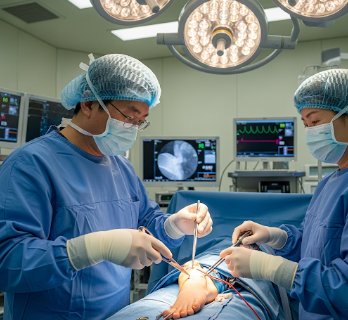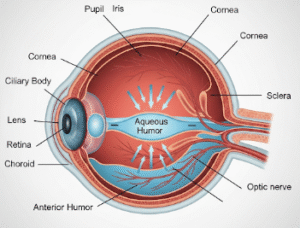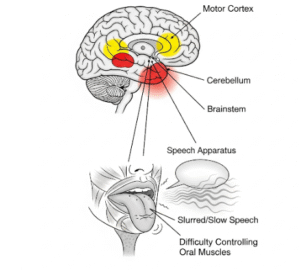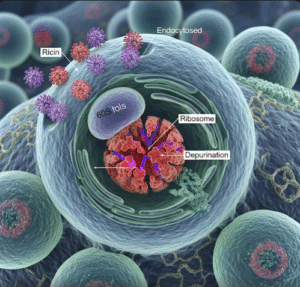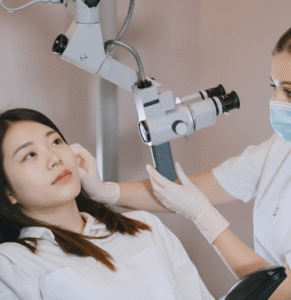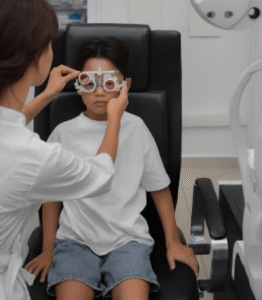Overview
Ankle Fusion, also known as ankle arthrodesis, is a surgical procedure designed to permanently join the bones of the ankle joint to relieve pain, improve stability, and restore function in patients with severe ankle conditions. This procedure is most commonly indicated for advanced arthritis, severe trauma, deformities, or failed previous ankle surgeries.
In Korea, ankle fusion is performed by expert orthopedic surgeons using modern surgical techniques such as open surgery, minimally invasive approaches, and advanced fixation devices. Korean hospitals offer comprehensive preoperative planning, state-of-the-art operating rooms, and post-operative rehabilitation programs, ensuring patients regain mobility and quality of life with minimal complications.
What is Ankle Fusion?
Ankle fusion involves surgically joining the tibia (shinbone) and talus (ankle bone) to form a single, solid bone, eliminating movement at the painful joint. The goal is to relieve chronic pain while maintaining the ability to walk and perform daily activities.
Types of ankle fusion include:
- Open Ankle Fusion: Traditional surgery involving a larger incision to access the joint directly.
- Arthroscopic Fusion: Minimally invasive surgery using small incisions and a camera to guide joint preparation and fixation.
- Mini-open or Robotic-assisted Fusion: Advanced techniques that enhance precision, reduce soft tissue damage, and accelerate recovery.
Ankle fusion is often considered when conservative treatments such as medication, physical therapy, or braces fail to control pain.
What are the benefits?
- Relieves chronic pain caused by arthritis or injury
- Corrects deformity and improves alignment of the ankle
- Stabilizes the joint, allowing better walking and mobility
- Prevents progression of joint degeneration
- ✅ Minimally invasive techniques in Korea reduce hospital stay, post-operative pain, and recovery time
- ✅ High success rates with modern fixation methods, ensuring long-term stability and improved quality of life
Procedure Details
1) How should I prepare for Ankle Fusion?
- ➤ Medical evaluation including blood tests, imaging (X-ray, CT, MRI), and cardiovascular assessment
- ➤ Discuss medications with your doctor, especially blood thinners, as they may need to be paused
- ➤ Stop smoking and maintain healthy nutrition to improve bone healing
- ➤ Preoperative counseling about surgery, recovery, and rehabilitation expectations
- ➤ Arrange post-surgery support at home for mobility assistance during early recovery
2) What happens during the procedure Ankle Fusion?
- ✅ The surgery is performed under general or regional anesthesia
- ✅ Surgeon prepares the ankle joint by removing damaged cartilage and reshaping the bone surfaces
- ✅ Bone grafts may be used to fill gaps and encourage solid fusion
- ✅ The tibia and talus are aligned and fixed using screws, plates, or rods
- ✅ Incisions are closed, and the ankle is immobilized in a cast or splint
- ✅ The procedure usually lasts 1–2 hours, depending on complexity
3) What happens after an Ankle Fusion?
- ➤ Patients are monitored in the recovery room for pain control and vital signs
- ➤ Elevate the leg to reduce swelling and promote healing
- ➤ Weight-bearing is usually restricted for 6–12 weeks, depending on fusion progress
- ➤ Physical therapy begins with gentle movement of surrounding joints and progresses to gait training
- ➤ Full recovery may take 3–6 months, with gradual return to daily activities
Risks / Benefits
Potential Risks:
- ➤ Infection at the surgical site
- ➤ Non-union or delayed bone fusion
- ➤ Blood clots
- ➤ Nerve or blood vessel injury
- ➤ Persistent pain or stiffness
Benefits:
- ✅ Permanent pain relief in the affected ankle
- ✅ Improved stability and walking ability
- ✅ Corrects malalignment and prevents further joint damage
- ✅ High success rates in Korea due to advanced surgical techniques and rehabilitation programs
- ✅ Restores quality of life and ability to perform daily activities
Recovery and Outlook
Recovery after ankle fusion involves several stages:
- Hospital stay: Usually 1–3 days depending on surgical complexity
- Initial immobilization: 6–12 weeks with a cast or boot to protect the fusion site
- Gradual weight-bearing: Under the guidance of a physical therapist
- Physical therapy: Strengthening, balance training, and gait improvement
- Full recovery: Most patients resume normal walking and low-impact activities within 3–6 months
- Patients often experience dramatic pain relief and improved stability, though the fused joint will no longer move
When To Call the Doctor
- ➤ Redness, swelling, or discharge at the incision site
- ➤ Fever or signs of infection
- ➤ Persistent or worsening pain
- ➤ Difficulty with mobility or unexpected complications
- ➤ Numbness or tingling in the foot
Best Korea Option / Process
- ✅ Korea is renowned for orthopedic and foot surgery, including ankle fusion
- ✅ Leading hospitals in Seoul and Busan offer arthroscopic, open, and robotic-assisted ankle fusion
- ✅ Hospitals provide preoperative planning, surgery, and comprehensive rehabilitation programs
- ✅ Advanced imaging and surgical tools improve precision, fusion success, and recovery time
- ✅ International patients benefit from English-speaking coordinators, VIP services, and post-surgery support
- ✅ Cost-effective treatment with excellent functional outcomes and minimal complications

